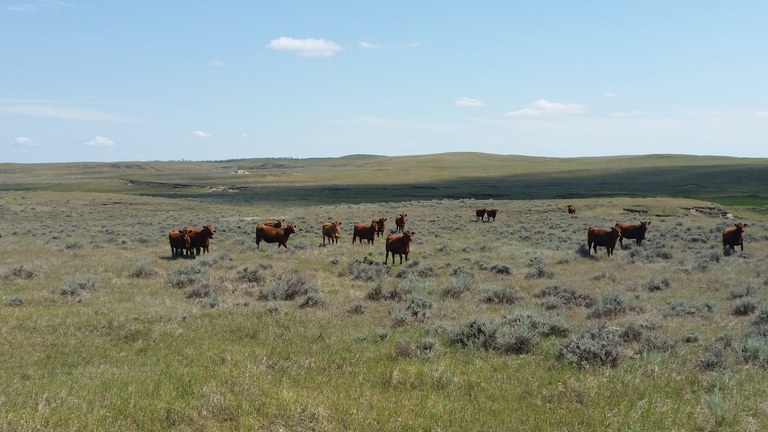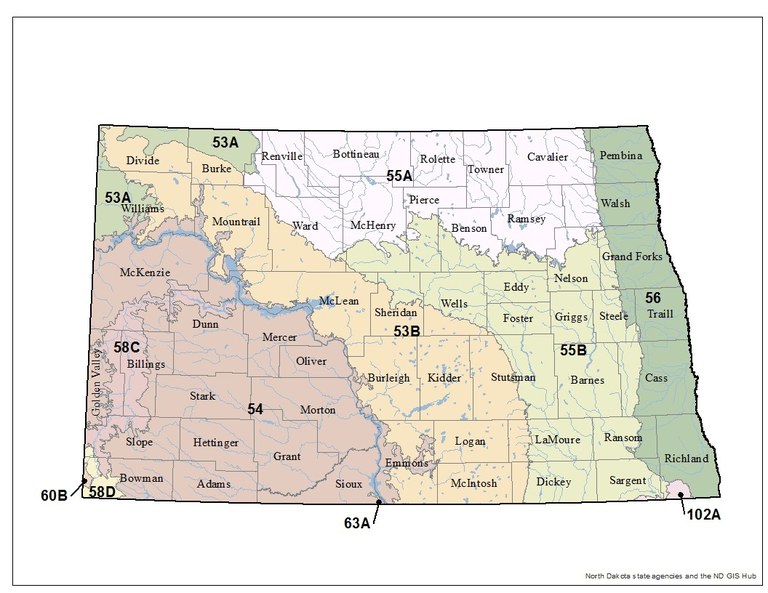(for rangeland pastures only)
To determine carrying capacity using estimated AUM/acre, multiply the acres of vegetation type by the recommended estimated stocking rate from Table 3 to determine AUM available (see formula below or Worksheet B of the Range Calculator). Repeat for each vegetation type found in the pasture. Total the results of each vegetation type to determine the total AUM available for the pasture.
Table 3. Estimated stocking rate guide in animal unit months per acre (AUM/ac) by site and multiple land resource areas (MLRA) for the reference plant community associated with each vegetation type/ecological site (modified from Sedivec and Printz (2012) – Ecological Sites of North Dakota).
(Use for rangeland pastures only)
| Vegetation Type/Ecological Site |
53A&B |
54 |
55A&B |
56 |
58 C&D |
| Upland |
|
|
|
|
|
| -- Loamy |
0.66 |
0.66 |
0.71 |
0.85 |
0.57 |
| -- Sandy |
.068 |
0.66 |
0.77 |
0.85 |
0.55 |
| -- Clayey |
0.63 |
0.57 |
0.66 |
0.82 |
0.52 |
| Shallow |
0.60 |
0.38 |
0.52 |
0.60 |
0.36 |
| Very Shallow/Thin claypan |
0.30 |
0.24 |
0.37 |
0.43 |
0.22 |
| Lowland |
|
|
|
|
|
| -- Overflow |
0.96 |
0.87 |
1.01 |
1.15 |
0.57 |
| -- Wet meadow |
0.60 |
0.60 |
0.60 |
0.70 |
0.60 |
Finally, the landowner can determine the carrying capacity for the planned class or type of livestock. Once the carrying capacity is determined using the estimated stocking rate guide from Table 3, divide total AUMs by total acres and then divide by AUE to calculate your animal unit equivalent months per acre (AUEM/ac). The AUEM per acre is an estimate of how many acres are required to support the kind and class of livestock you are grazing for a period of one month.
If harvest efficiency has been improved through the implementation of a properly managed grazing system, multiply total AUM by the guideline multiplier value found in Table 2 (multiplier column).
Formula:
|
Acres if Vegetation Type
|
x
|
AUM/acre1
|
=
|
AUM2
|
Expressed Carrying Capacity:
|
AUM
|
÷
|
total acres
|
÷
|
AUE3
|
=
|
AUEM/ac
|
1 AUM/acre (Table 3) for vegetation type based on a 0.25 harvest efficiency.
2 AUM must be calculated for each vegetation type.
3 AUE for your livestock class or type found in Table 1.
Example 3
1,000-acre rangeland pasture grazed seasonlong containing 790 acres of loamy upland, 150 acres of shallow, 50 acres of overflow and 10 acres of wet meadow near Steele, N.D. (MLRA 53B1). Range unit is grazed by 1,300-lb. cow with calf.
|
Site Type
|
Acres
|
x
|
AUM/ac2
|
=
|
AUM |
|
Loamy
|
790
|
x
|
0.66
|
=
|
521.4
|
| Shallow |
150
|
x
|
0.60
|
=
|
90.0
|
| Overflow |
50
|
x
|
0.96
|
=
|
48.0
|
| Wet meadow |
10
|
x
|
0.60
|
=
|
6.0
|
| Total |
1,000 |
|
|
=
|
665.4
AUM for total pasture
|
1 Figure 1.
2 The animal unit months/acre found in Table 3 is based on a 0.25 harvest efficiency under seasonlong grazing and the 0.125 harvest efficiency for wet meadow communities.
Expressed Carrying Capacity:
|
665.4 AUM
|
÷
|
1,000 acres
|
÷
|
1.22 AUE
|
=
|
0.55 AUEM/ac
|
or
1 ÷ 0.55 AUEM/ac = 1.82 acres per month for each 1,300-lb. cow with calf.
Example 4
Same as Example 1 but managed using an approved grazing system with mature sheep with lambs.
With an approved grazing system and using a 35 percent harvest efficiency, multiplier value is 1.4 (Table 2).
So, 671.7 AUM x 1.4 = 940.4 AUM.
1 from Example 1
Expressed Carrying Capacity:
|
940.4 AUM
|
÷
|
1,000 acres
|
÷
|
0.20 AUE
|
=
|
4.7 AUEM/ac
|
or
1 ÷ 4.7 AUEM/ac = 0.21 acre per month for each sheep with lamb.
To convert AUM/ac to ac/AUM, divide 1 by AUM/acre. For example, 0.66 AUM/ac would be 1 ÷ 0.67 = 1.49 ac/AUM.


